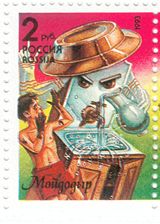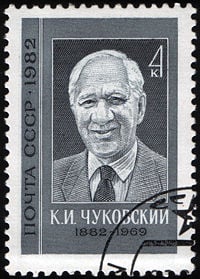Korney Chukovsky
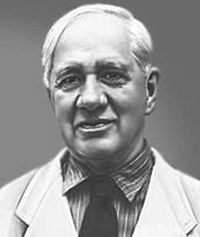 | |
| Born: | April 31 1882 |
|---|---|
| Died: | 28 October 1969 (aged 87) |
Korney Ivanovich Chukovsky (Russian: Корней Иванович Чуковский, March 31 NS 1882 - October 28 1969) was one of the most popular children's poets in the Russian language. His poems, Doctor Aybolit (Айболит), The Giant Roach (Тараканище), The Crocodile (Крокодил), and Wash'em'clean (Мойдодыр) have been favourites with many generations of Russophone children. He also was an influential literary critic and essayist.
Early life
Nikolay Vasilyevich Korneychukov was his original name (Russian: Николай Васильевич Корнейчуков), which he reworked into his now familiar pen-name while working as a journalist at Odessa News in 1901. He was born in St.Petersburg, the illegitimate son of Ekaterina Osipovna Korneychukova (a peasant girl from the Poltava region of Ukraine) and Emmanuil Solomonovich Levinson, a man from a wealthy Jewish family (his legitimate grandson was mathematician Vladimir Abramovich Rokhlin). Levinson's family did not permit his marriage to Korneychukova, and they eventually separated. Korneychukova moved to Odessa with Nikolay and his sibling. Levinson supported them financially for some time until his marriage to another woman. Nikolay studied at the Odessa gymnasium, where one of his classmates was Vladimir Zeev Jabotinsky. Later, Nikolay was expelled from the gymnasium for his "low origin" (an euphemism for illegitimacy). He had to get his secondary school and university diplomas by correspondence.
He taught himself English, and, in 1903-05, he served as the London correspondent at an Odessa newspaper, although he spent most of his time at the British Library instead of the press gallery in the Parliament. Back in Russia, Chukovsky started translating English works, notably Walt Whitman, and published several analyses of contemporary European authors, which brought him in touch with leading personalities of Russian literature and secured the friendship of Alexander Blok. His influence on Russian literary society of the 1890s is immortalized by satirical verses of Sasha Cherny, including Korney Belinsky (an allusion to the famous critic Vissarion Belinsky). Later he published several notable literary titles including From Chekhov to Our Days (1908), Critique stories (1911), and Faces and masks (1914). He also published a satirical magazine called Signal (1905-1906) and was arrested for "insulting the ruling house," but was acquitted after six months.
Later life
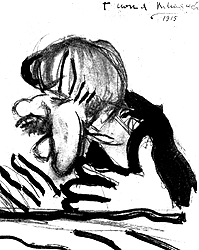
It was at that period that Chukovsky produced his first fantasies for children. As the 2004 Encyclopædia Britannica put it, "their clockwork rhythms and air of mischief and lightness in effect dispelled the plodding stodginess that had characterized pre-revolutionary children's poetry." Subsequently, they were adapted for theatre and animated films, with Chukovsky as one of the collaborators. Sergei Prokofiev and other composers even adapted some of his poems for opera and ballet. His works were popular with emigre children as well, as Vladimir Nabokov's complimentary letter to Chukovsky attests.
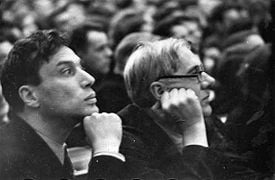
During the Soviet period, Chukovsky edited the complete works of Nikolay Nekrasov and published From Two to Five (1933), a popular guidebook to the language of children. As his invaluable diaries attest, Chukovsky used his popularity to help the authors persecuted by the regime including Anna Akhmatova, Mikhail Zoshchenko, Alexander Galich, and Aleksandr Solzhenitsyn. He was the only Soviet writer who officially congratulated Boris Pasternak on his having been awarded the Nobel Prize. His daughter, Lydia Chukovskaya, is remembered as a lifelong companion and secretary of the poet Anna Akhmatova.
At one point his writings for children were under severe criticism. Nadezhda Krupskaya was an initiator of this campaign, but criticism also came also from children's writer Agniya Barto.
Starting in the 1930s, Chukovsky lived in the writers' village of Peredelkino near Moscow, where he is now buried.
For his works on the life of Nekrasov he was awarded a Doctor of Science degree in philology. He also received the Lenin Prize in 1962 for his book, Mastery of Nekrasov and an honorary doctorate from Oxford University in 1962.
Works
Moidodyr (1923) is a poem for children by Korney Chukovsky about a magical creature by the same name. The name may be translated as "Wash'em'clean".
The poem is about a small boy who does not want to wash. He gets so dirty that all his toys, clothes and other possessions decide to magically leave him. Suddenly, from the boy's mother's bedroom appears Moidodyr - an anthropomorphic washstand. He claims to have powers over all washstands, soap bars and sponges. He scolds the boy and calls his soap bars and sponges to wash him. The boy tries to run away, chased by a vicious sponge. The chase is described as happening on St. Petersburg streets. Finally they meet another recurring character from Chukovsky's books - the Crocodile. The Crocodile swallows the sponge and becomes angry with the boy for being so dirty. Scared by the Crocodile, the boy goes back to Moidodyr and takes a bath. The poem ends with a moralistic note to children on the virtue of hygiene.
Moidodyr character became a symbol of clearness in Russia and is often used to advertise detergents and other products.
External links
- (Russian)Site devoted to Chukovsky
- (Russian)Korney Chukovsky Live as Life
- (Russian)Biography
- (Russian)Site devoted to Chukovsky
- (Russian)Valentin Berestov 'He gave his life to art without change
- (Russian)Dmitry Bykov about Chukovsky
Credits
New World Encyclopedia writers and editors rewrote and completed the Wikipedia article in accordance with New World Encyclopedia standards. This article abides by terms of the Creative Commons CC-by-sa 3.0 License (CC-by-sa), which may be used and disseminated with proper attribution. Credit is due under the terms of this license that can reference both the New World Encyclopedia contributors and the selfless volunteer contributors of the Wikimedia Foundation. To cite this article click here for a list of acceptable citing formats.The history of earlier contributions by wikipedians is accessible to researchers here:
The history of this article since it was imported to New World Encyclopedia:
Note: Some restrictions may apply to use of individual images which are separately licensed.
